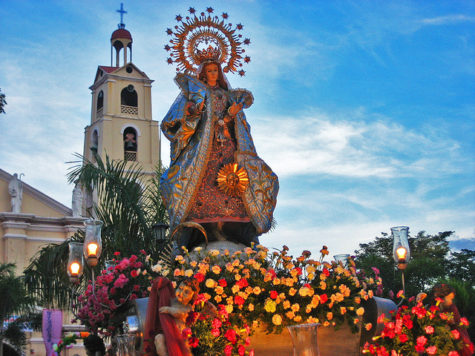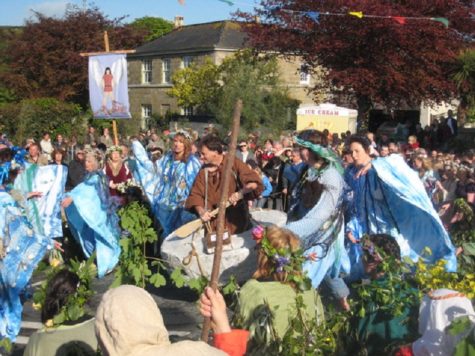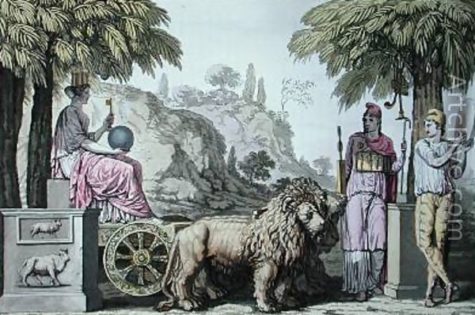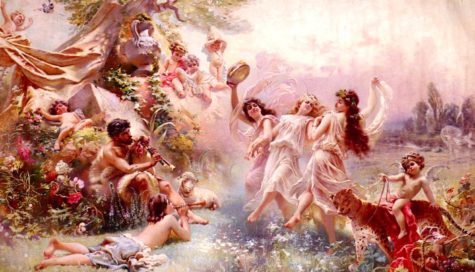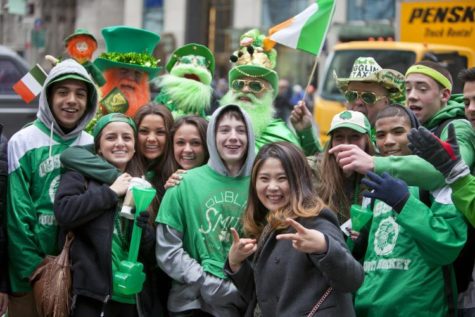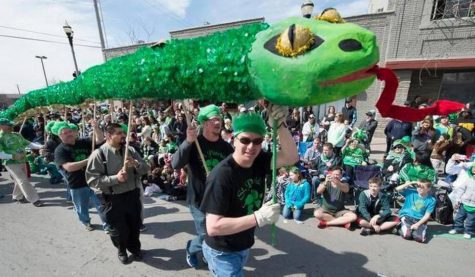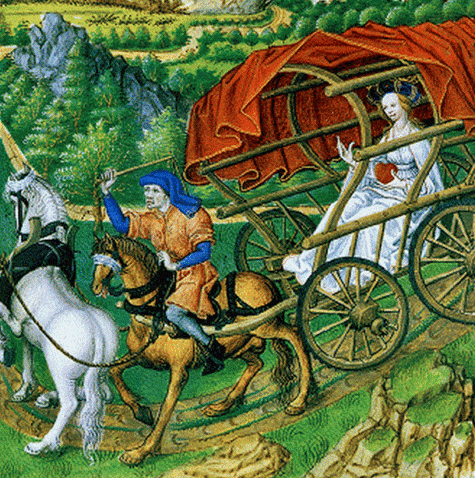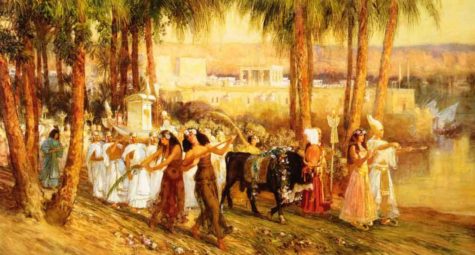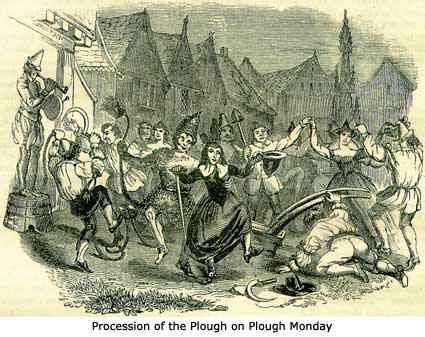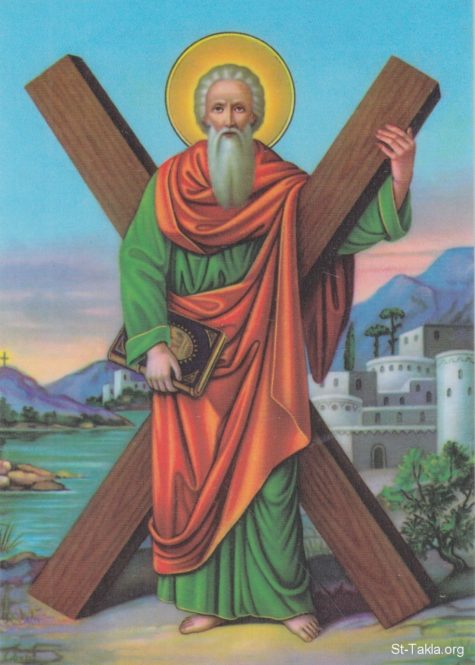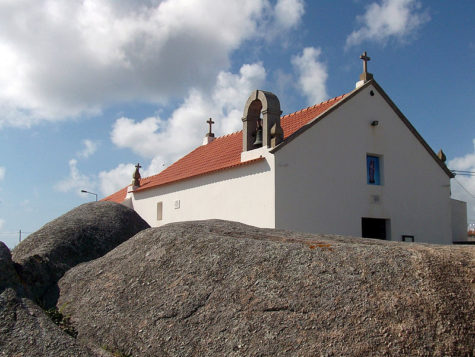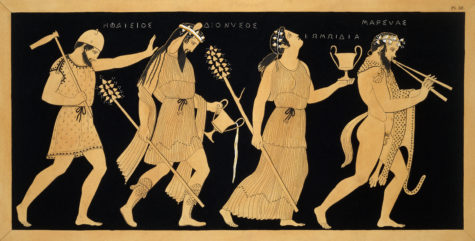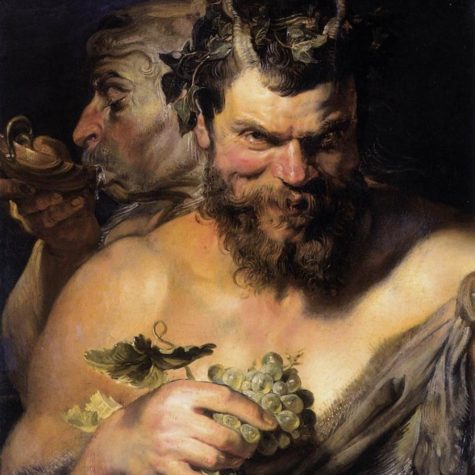Parades
Flores de Mayo (Spanish for “flowers of May”) is a festival held in the Philippines in the month of May. It is one of the May devotions to the Blessed Virgin Mary and lasts for the entire month.
The Santacruzan (from the Spanish santa cruz, “holy cross”) is the ritual pageant held on the last day of the Flores de Mayo. It honors the finding of the True Cross by Helena of Constantinople (known as Reyna Elena) and Constantine the Great. Its connection with May stems from the old May 3 date of Roodmas, which Pope John XXIII abolished in 1960 in favour of the Feast of the Exaltation of the Cross on September 14
Regional Celebrations:
- In the Bicol Region, the ritual begins with the recitation of the rosary, and the last day is simply called the “katapusan”.
- In Western Visayas, the towns have their respective chapels where an image of the Virgin Mary is venerated and children gather to have a simple catechism and teachings about the life and story of Mary. They were also taught some prayers and songs recited only during the Flores de Mayo and the children offer flowers before the image of the Virgin Mary as a symbol of love, affection and veneration.
- Some churches and areas give children paper tickets for actively participating during the catechism and at the end of the month of May, the children redeem the value of the tickets which are school supplies ready for the school opening in June. Santacrusan is usually held during the last few days of May to coincide with the end of the catechism for children.
- Amongst the Tagalog people, the custom began after the publication of Mariano Sevilla’s translation of the devotional “Flores de María” or “Beautiful Flowers that in the Meditations in the Whole Month of May are Offered by Devotees to Mary Most Holy.”
- One famous May tradition in Batangas is the Luglugan, or nightly devotion and party honoring the Virgin Mary. Held in structures called tuklóng, devotees offer flowers and prayers to an image of Mary every night. After the prayer, the Hermanos or Hermanas for the day will give away treats to the participants, followed by the party. The Luglugan lasts for a month until the Tapusan (“ending”) which is marked with a Mass, a Santacruzan and procession of the Blessed Virgin Mary, and capped with a final Luglugan that lasts until the following morning.
- A Santacruzan is a religio-historical beauty pageant held in many cities, towns, and even in small communities throughout the Philippines during the month of May.
The Santacruzan Procession and Pageant
 One of the most colorful aspects of this festival, the pageant depicts the finding of the True Cross by Queen Helena, mother of Constantine the Great. Many movie and television personalities participate in the events and are featured in major santacruzan. This festival became part of Filipino traditions identified with youth, love, and romance.
One of the most colorful aspects of this festival, the pageant depicts the finding of the True Cross by Queen Helena, mother of Constantine the Great. Many movie and television personalities participate in the events and are featured in major santacruzan. This festival became part of Filipino traditions identified with youth, love, and romance.
Prior to the Santacruzan, a novena is held in honor of the Holy Cross. The procession itself commemorates the search of the Holy Cross by Reyna Elena and her son, Emperor Constantine. It is said to have roots in the joyous thanksgiving celebrations that followed the finding of the Holy Cross in Jerusalem and its translation to Constantinople (now İstanbul).
The procession is accompanied by the steady beat of a local brass band, playing and singing the Dios te salve (the Spanish version of the Hail Mary). Devotees hold lighted candles and sing the prayer as they walk. It is customary for males participating in the Santacruzan to wear the traditional Barong Tagalog and that the females wear any Filipiniana-inspired dress.
After the procession in some places, there is the pabítin game (in Cavite, it is called “agaw-bitin”) that serves as a culminating activity for the children. The pabítin is a square-shaped bamboo grille or frame to which goodies (candies, fruits, small trinkets, etc.) are tied with thin strings.
This grille in turn is tied to a long rope passed over a strong branch or pole some 2 metres above the ground. Children then gather under the frame as the it is slowly lowered, and they then jump as high as they could to grab the goodies while someone jerks it up and down repeatedly until all the prizes are gone.
Sometimes the palosebo (the local version of the greasy pole) is also played, where a tall bamboo pole is smeared with grease which participants must climb to get a small red banner or a bag with a prize, such as ₱500 or a higher amount.
For a Magickal Flores de Mayo
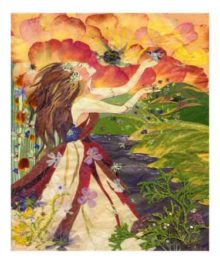 From 360 Goddess, we have a different version of, and way to celebrate the Flores de Mayo. This can be celebrated any time during the month of May, or on the last day, as a sort of magickal Santacruzan.
From 360 Goddess, we have a different version of, and way to celebrate the Flores de Mayo. This can be celebrated any time during the month of May, or on the last day, as a sort of magickal Santacruzan.
- Themes: Offering; Prayer; Love; Devotion; Home; Relationships
- Symbols: Spring; May Blossoming Flowers
- Presiding Goddess: Sisina
About Sisina:
This Filipino goddess oversees the realms of orderliness, beauty, and love. Traditionally, she protects marriages against discord, but she may also be called upon to settle inner turmoil within your soul and restore self-love.
To do today:
People in the Philippines say good-bye to May with bouquets, flower offerings, and an array of sweet foods to honor the month’s sweetness and beauty. Sometimes they ask Sisina to join the festivities by setting a place for her at the table.
This particular custom appears in several other cultures and it is a simple, lovely way of honoring the goddess. Just leave a plate with a fresh flower on your dinner table. This draws Sisina’s presence, love, and peaceful nature to your home and family relationships. If you wish, also leave an offering of sweet bread or fruity wine in a special spot to thank her.
As you go about your normal routine today, take time to enjoy any flowers you see, and be very considerate of the special people in your life. Sisina will see the effort and continue blessing those relationships with harmony.
Sources: 365 Goddess and wikipedia
The Furry Dance, also known as The Flora (or incorrectly as the Floral Dance), takes place in Helston, Cornwall, and is one of the oldest British customs still practiced today. The Dance takes place every year on May 8 (or the Saturday before if May 8 falls on a Sunday or Monday), and is a celebration of the passing of Winter and the arrival of Spring.
The dance is very well attended every year. Winter’s gone, so everybody’s out in the streets to celebrate the new life springing up all around. It seems like the whole of Cornwall is lining the streets, all freshly decorated with colourful flowers
The four dances and a Hal-an-Tow (a mystery play), spread across the day, starting with the first dance at 7.00 am, continuing with the children’s dance at 10.00 am, then the midday dance and culminating in the evening dance at 5.00 pm. Of these, the midday dance is perhaps the best known: it was traditionally the dance of the gentry in the town, and today the men wear top hats and tails while the women dance in their finest frocks.
The Dance twists and turns its way through this ancient Cornish town and the route doesn’t change, even if that means that the Flora Dance has to traipse through people’s houses, across their gardens or straight through the shops.
The whole town is decorated with greenery, many of the people are wearing greenery outfits and the Town Band play all day long, providing music to the dancers, they have a splash of greenery in their hats too, you’ll notice this is Lily of the Valley, which is Helston’s symbolic flower. The gentlemen wear it on the left, with the flowers pointing upwards, and the ladies wear it upside down on the right.
Originally, most likely, a May Day celebration, it was moved to May 8th to commemorate the town’s patron saint, St Michael, who is said to have saved the town from what appears to be a meteorite hit in AD 495, you can still see the boulder that crashed down as it’s still visible as a wall in the Angel Yard.
Source: Cornish Festivals
Have Your Own Furry Dance:
The Furry Dance is an ancient festival that rejoices in spring’s warmth and beauty. To bring this energy into your life, it’s customary to dance with a partner. In fact, the more people you can get dancing, the more fortunate the energy! Usually this is done on the streets throughout a town as a show of regional unity, but when propriety won’t allow such a display, just dance around a room together instead. Don’t worry about the steps – just do what feels right.
- Themes: Unity; Joy; Luck
- Symbols: Flowers; Triangle
- Presiding Goddess: Tanat
In Cornwall, Tanat is the mother goddess of fertility who has given all her attention to nursing spring into its fullness. She also staunchly protects her children (nature and people) so that our spirits can come to know similar fulfillment.
Wearing something with floral or triangular motifs (guys, wear a necktie, and gals, pull out a square scarf and fold it crosswise) activates Tanat’s happiness in your life and in any region where you have the token on today. As you don the item, say:
Liberate happiness in and around,
by Tanat’s blossoming power, joy will be found!
Or if you want to use the same thing to generate unity and harmony, use this incantation:
Harmony and unity,
Tanat’s blessings come to me.
From: 365 Goddess
The Megalisia was a Phrygian festival in honor of Cybele, the Magna Mater. This was a festival with games celebrated at Rome in the month of April and in honor of the great mother of the gods. Following the advice of the Sibylline oracle on how to end the Punic wars, the meteorite which represented Cybele was brought from Phrygia to Rome in 204 BCE where it was installed in the Temple of victory on April 4th. The day of its arrival was solemnized with a magnificent procession, lectisternia, and games, and great numbers of people carried presents to the goddess at the Capitol.
The following harvest was great and the war ended the next year.
The regular celebration of the Megalesia, however, did not begin until about a dozen years later, when the temple which had been vowed and ordered to be built in 203 B.C., was completed and dedicated by M. Iunius Brutus.
The Romans began the celebrations with a parade, in which an image of the Goddess, Cybele, was carried through the streets in a chariot drawn by lions, her animals. The castrated priests who served her danced alongside, playing timbrels and cymbals and gashing themselves. Lucretius says “with bronze and silver they strew all the paths of her journey … and snow rose-blossoms over her.”Rome, commemorating the arrival of the goddess to her Roman Temple.”
The festival lasted for six days, beginning on the 4th of April. The season of this festival, like that of the whole month in which it took place, was full of general rejoicings and feasting. It was customary for the wealthy Romans on this occasion to invite one another mutually to their repasts, and the extravagant habits and the good living during these festive days were probably carried to a very high degree. For that reason, a senatusconsultum was issued in 161 B. C., prescribing that no one should go beyond a certain extent of expenditure.
The games which were held at the Megalesia were purely scenic, and not circenses. They were at first held on the Palatine in front of the temple of the goddess, but afterwards also in the theaters.
The first ludi scenici at Rome were, according to Valerius Antias, introduced at the Megalesia, either in 193 or 191 b.c. The day which was especially set apart for the performance of scenic plays was the third of the festival.
Slaves were not permitted to be present at the games, and the magistrates appeared dressed in a purple toga and praetexta, whence the proverb, purpura Megalensis. The games were under the superintendence of the Curule Aediles, and we know that four of the extant plays of Terence were performed at the Megalesia. Cicero, probably contrasting the games of the Megalesia with the more rude and barbarous games and exhibitions of the circus, calls them maxime casti, solemnes, religiosi.
Source: Nova Roma and Smith, Dictionary of Greek and Roman Antiquities
Note:
The book, 365 Goddess, describes this festival as a Roman Festival celebrating the accuracy of the Sibylline oracles, who predicted the way for the Roman victory in the Punic Wars. Her suggestions for celebrating this ancient festival is as follows:
- Themes: Divination, Protection, Victory, Children, Birth, Communication.
- Symbols: The written word, Divination tools, Fertility symbols.
- Rulers: The Carmenae.
The Carmenae is a group of goddesses who correspond to the Muses of Greek tradition; they know our past, see what’s in store in the future, foretell children’s fates, and teach us the effective use of “letters” (the alphabet), the arts, and how to tell fortunes. They also oversee midwives.
Romans traditionally honored the goddesses today with music and song, so put on some magical tunes! The Carmenae will saturate the music and uplift your spirit.
Ask the Carmenae to help you write personalized invocations or spells today. Put pen to pad and let these goddesses inspire sacred words suited to your path and needs. Keep these in a magick journal for future use.
The Roman oracles often drew lots to determine a querent’s answer. If you have a question weighing heavily on your heart today, follow this custom and take out some variegated beans. Hold them. Concentrate on the question, then pick out one bean. A black one means “no”; white means “yes.” Red means that anger is driving action, brown means things are muddled, and green indicates growth potential. If you don’t have the beans, colored buttons or beads are a suitable alternative.
March 17 commemorates Saint Patrick, the patron saint and national apostle of Ireland, and the arrival of Christianity in Ireland. In addition, this day also celebrates the heritage and culture of the Irish in general.
Celebrations generally involve public parades and festivals, céilithe (Irish traditional music sessions), and the wearing of green attire or shamrocks. There are also formal gatherings such as banquets and dances, although these were more common in the past. St Patrick’s Day parades began in North America in the 18th century but did not spread to Ireland until the 20th century.
The participants generally include marching bands, the military, fire brigades, cultural organisations, charitable organisations, voluntary associations, youth groups, fraternities, and so on. However, over time, many of the parades have become more akin to a carnival. More effort is made to use the Irish language; especially in Ireland, where the week of St Patrick’s Day is “Irish language week”. Recently, famous landmarks have been lit up in green on St Patrick’s Day.
Christians also attend church services and the Lenten restrictions on eating and drinking alcohol are lifted for the day. Perhaps because of this, drinking alcohol – particularly Irish whiskey, beer or cider – has become an integral part of the celebrations.
The St Patrick’s Day custom of ‘drowning the shamrock‘ or ‘wetting the shamrock‘ was historically popular, especially in Ireland. At the end of the celebrations, shamrock is put into the bottom of a cup, which is then filled with whiskey, beer or cider. It is then drank as a toast; to St Patrick, to Ireland, or to those present. The shamrock would either be swallowed with the drink, or be taken out and tossed over the shoulder for good luck.
In every household the herb is placed upon the breakfast table of the master and the mistress, who “drown the shamrock” in generous draughts of whiskey, and then send the bottle down into the kitchen for the servants.
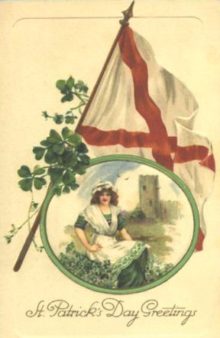 On St Patrick’s Day it is customary to wear shamrocks and/or green clothing or accessories (the “wearing of the green”). St Patrick is said to have used the shamrock, a three-leaved plant, to explain the Holy Trinity to the pagan Irish. This story first appears in writing in 1726, though it may be older.
On St Patrick’s Day it is customary to wear shamrocks and/or green clothing or accessories (the “wearing of the green”). St Patrick is said to have used the shamrock, a three-leaved plant, to explain the Holy Trinity to the pagan Irish. This story first appears in writing in 1726, though it may be older.
Long before the shamrock became associated with St. Patrick’s Day, the four-leaf clover was regarded by ancient Celts as a charm against evil spirits.
In pagan Ireland, three was a significant number and the Irish had many triple deities, a fact that may have aided St Patrick in his evangelisation efforts. Patricia Monaghan says there is no evidence that the shamrock was sacred to the pagan Irish. However, Jack Santino speculates that it may have represented the regenerative powers of nature, and was recast in a Christian context—icons of St Patrick often depict the saint “with a cross in one hand and a sprig of shamrocks in the other”. Roger Homan writes, “We can perhaps see St Patrick drawing upon the visual concept of the triskele when he uses the shamrock to explain the Trinity”.
In the early 1900’s, O. H. Benson, an Iowa school superintendent, came up with the idea of using a clover as the emblem for a newly founded agricultural club for children in his area. In 1911, the four-leaf clover was chosen as the emblem for the national club program, later named 4-H.
The color green has been associated with Ireland since at least the 1640’s, when the green harp flag was used by the Irish Catholic Confederation. Green ribbons and shamrocks have been worn on St Patrick’s Day since at least the 1680s. The Friendly Brothers of St Patrick, an Irish fraternity founded in about 1750, adopted green as its color.
However, when the Order of St. Patrick—an Anglo-Irish chivalric order—was founded in 1783 it adopted blue as its color, which led to blue being associated with St Patrick. During the 1790’s, green would become associated with Irish nationalism, due to its use by the United Irishmen. This was a republican organisation—led mostly by Protestants but with many Catholic members—who launched a rebellion in 1798 against British rule.
The phrase “wearing of the green” comes from a song of the same name, which laments United Irishmen supporters being persecuted for wearing green. Throughout the 19th and 20th centuries, the color green and its association with St Patrick’s Day grew.
The wearing of the ‘St Patrick’s Day Cross’ was also a popular custom in Ireland until the early 20th century. These were a Celtic Christian cross made of paper that was “covered with silk or ribbon of different colors, and a bunch or rosette of green silk in the center”.
The most popular of the many legends about St. Patrick is the one which credits him for having driven all the snakes and vermin out of Ireland.
Here’s an old old poem about it:
There’s not a mile in Ireland’s isle
where the dirty vermin musters;
Where’er he put his dear forefoot
he murdered them in clusters.
The toads went hop, the frogs went flop,
slap dash into the water,
And the beasts committed suicide to
save themselves from slaughter.
Nine hundred thousand vipers blue
he charmed with sweet discourses.
And dined on them at Killaloo
in soups and second courses.
When blindworms crawling on the grass
disgusted all the nation,
He gave them a rise and opened their eyes
to a sense of the situation.
The Wicklow Hills are very high, and
so’s the Hill of Howth, sir;
But there’s a hill much higher still—ay,
higher than them both, sir;
‘Twas on the top of this high hill St.
Patrick preached the sarmint
That drove the frogs into the bogs and
bothered all the varmint.
About St Patrick
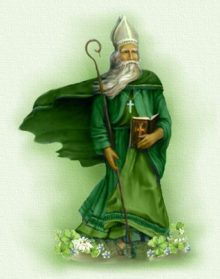 Patrick was a 5th-century Romano-British Christian missionary and bishop in Ireland. Much of what is known about Saint Patrick comes from the Declaration, which was allegedly written by Patrick himself. It is believed that he was born in Roman Britain in the fourth century, into a wealthy Romano-British family. His father was a deacon and his grandfather was a priest in the Christian church.
Patrick was a 5th-century Romano-British Christian missionary and bishop in Ireland. Much of what is known about Saint Patrick comes from the Declaration, which was allegedly written by Patrick himself. It is believed that he was born in Roman Britain in the fourth century, into a wealthy Romano-British family. His father was a deacon and his grandfather was a priest in the Christian church.
According to the Declaration, at the age of sixteen, he was kidnapped by Irish raiders and taken as a slave to Gaelic Ireland. ] It says that he spent six years there working as a shepherd and that during this time he “found God”. The Declaration says that God told Patrick to flee to the coast, where a ship would be waiting to take him home. After making his way home, Patrick went on to become a priest.
According to tradition, Patrick returned to Ireland to convert the pagan Irish to Christianity. The Declaration says that he spent many years evangelising in the northern half of Ireland and converted “thousands”. Patrick’s efforts against the druids were eventually turned into an allegory in which he drove “snakes” out of Ireland (Ireland never had any snakes).
Tradition holds that he died on 17 March and was buried at Downpatrick. Over the following centuries, many legends grew up around Patrick and he became Ireland’s foremost saint.
NOTE:
What many people don’t realize is that the serpent was actually a metaphor for the early Pagan faiths of Ireland. St. Patrick brought Christianity to the Emerald Isle, and did such a good job of it that he practically eliminated Paganism from the country. Because of this, some modern Pagans refuse to observe a day which honors the elimination of the old religion in favor of a new one. It’s not uncommon to see Pagans and Wiccans wearing some sort of snake symbol on St. Patrick’s Day, instead of those green “Kiss Me I’m Irish” badges.
Sources: Almanac.com, Wikipedia, and Encyclopaedia of Superstitions, Folklore, and the Occult Sciences
Snake Saturday Parade & Festival, celebrated on the Saturday before St Patrick’s Day, has become the largest family fun Irish celebration in the Kansas City Metro area. It also generates an enormous amount of exposure and charitable donations to benefit local non-profit organizations.
Each year Snake Saturday Parade & Festival awards cash prizes to some 50 –100 local charities that participate in the festivities.
Parade Founder Mickey Finn tells the story of how Snake Saturday came to life in 1983. The concept started as a promotion for Rodeway Inn, with four floats, a Grand Marshal and co-founder, Bill Grigsby. It was cold outside, only about ten degrees. The parade took place in the motel parking lot, allowing people to view from their hotel rooms and the coffee shop.
And what would a parade be without a winner of Best of Parade? A young lady on the back of a Harley Davidson motorcycle wearing a bright green bikini took home the honor. After the parade, the North Kansas City mayor turned to Mickey Finn and said, “We might as well take it to the street next year.” And as they say, “the rest is history”. The parade has celebrated every year since, regardless of weather conditions and always on the Saturday before St. Patrick’s Day.
As the Snake Saturday Parade & Festival became the largest family fun Irish celebration in the area, it also generated an enormous amount of exposure and charitable donations benefiting local non-profit organizations. The process started after non-profit businesses were invited to build floats and compete for prize money. The response was overwhelming and community involvement soared to new heights.
Saturday Parade & Festival is made possible by wonderful, dedicated people, businesses, schools, police, fire, city staff, donors, volunteers, planners, participants and sponsors including North Kansas City, North Kansas City Hospital, North Kansas City Beverage and many more. It is the commitment of the entire community to keeping these festivities safe and fun for the whole family that has cultivated our success and has put us on the map as one of the best parade celebrations in the Midwest region.
Source: Snake Saturday
This is the name given to two festivals held in ancient Boeotia, which was a part of Greece, in honor of the reconciliation of Hera and Zeus. The dates of these festivals are somewhat nebulous and varied from place to place and year to year. One source cites March 10th.
The story:
According to the myth, Hera and Zeus quarreled and Hera went away to Euboea and refused to return to his bed. To trick her into coming back and on the advice of Cithaeron, Zeus dressed up a carved oak-trunk to resemble a bride and let it be known that he planned to marry Plataea, the daughter of Asopus. Hera was so angry she tore the clothes from the statue, discovered the deception, and was so pleased that the two were reconciled.
The festivities:
The Lesser Daedala (Δαίδαλα μικρά) was held every four to six years. The people of Plataea went to an ancient oak grove and exposed pieces of cooked meat to ravens, attentively watching upon which tree any of the birds, after taking a piece of meat, would settle. Out of this tree they carved an image, and having it dressed as a bride, they set it on a bullock cart with a bridesmaid beside it. The image seems then to have been drawn to the bank of the river Asopus and back to the town, attended by a cheering crowd.
After fourteen of these cycles (approx.59 or 60 years), the Greater Daedala (Δαίδαλα μεγάλα) was held, and all Boeotia joined in the celebration. At its start one wooden figure was chosen from the many that had accumulated through the years and designated the “bride”. The wooden figure was prepared as a bride for a wedding, ritually bathed in the Asopus, adorned and raised on a wagon with an attendant. This wagon led a procession of wains carrying the accumulated daedala (all the other images that had been created over the years) up to the summit of Mount Kithairon, where a wooden sacrificial altar was erected out of square pieces of wood.
This was covered with a quantity of dry wood, and the towns, persons of rank, and other wealthy individuals, offered each a heifer to Hera and a bull to Zeus with plenty of wine and incense, while at the same time all of the daedala were placed upon the altar. For those who did not possess sufficient means, it was customary to offer small sheep, but all these offerings were immolated in a hecatomb in the same manner as those of the wealthier persons. The fire consumed both offerings and altar
An ancient account of myth behind the festival is related by Pausanias:
“Hera, they say, was for some reason or other angry with Zeus, and had retreated to Euboia. Zeus, failing to make her change her mind, visited Kithairon, at that time despot in Plataea, who surpassed all men for his cleverness. So he ordered Zeus to make an image of wood, and to carry it, wrapped up, in a bullock wagon, and to say that he was celebrating his marriage with Plataia, the daughter of Asopus. So Zeus followed the advice of Kithairon.
Hera heard the news at once, and at once appeared on the scene. But when she came near the wagon and tore away the dress from the image, she was pleased at the deceit, on finding it a wooden image and not a bride, and was reconciled to Zeus. To commemorate this reconciliation they celebrate a festival called Daidala, because the men of old time gave the name of daidala to wooden images… the Plataeans hold the festival of the Daidala every six years, according to the local guide, but really at a shorter interval.
I wanted very much to calculate exactly the interval between one Daedala and the next, but I was unable to do so. In this way they celebrate the feast.”
Found at Wikipedia
When Egypt became part of the Roman Empire, Greek merchants brought the worship of Isis from Alexandria to Rome and invoked Her as inventor of the sail, patron of navigation, and ruler of the waves.
Possibly the most well known Isiac festival of the Roman world was the Navigium Isidis, celebrated on the 5th of March. As part of the festivities, a a festive carnival procession was performed in honor of Isis, and the Vessel of Isis, laden with offerings of precious spices and milk libations, is launched.
Here is a colorful and detailed eye-witness account of the procession and the ceremony:
Soon the sun of gold arose and sent the clouds of thick night flying; and lo, a crowd of people replenished the streets, filing in triumphal religious procession. It seemed to me that the whole world, independent of my own high spirits, was happy. The dusky clouds were routed; and the heavens shone with clear sheer splendor of their native light.
Presently the vanguard of the grand procession came in view. It was composed of a number of people in fancy dress of their own choosing; a man wearing a soldier’s sword-belt; another dressed as a huntsman, a thick cloak caught up to his waist with hunting knife and javelin; another who wore gilt sandals, a wig, a silk dress and expensive jewelry and pretended to be a woman.
Then a man with heavy boots, shield, helmet and sword, looking as though he had walked straight out of the gladiators’ school; a pretended magistrate with purple robe and rods of office; a philosopher with cloak, staff, clogs and billy-goat beard; a bird catcher, carrying lime and a long reed; a fisherman with another long reed and a fish hook.
Oh, yes, and a tame she-bear, dressed like a woman, carried in a sedan chair; and an ape in a straw hat and a saffron-coloured Phrygian cloak with a gold cup grasped in its paws – a caricature of Jupiter’s beautiful cup-bearer Ganymede.
Finally an ass with wings glued to its shoulders and a doddering old man seated on its rump; you would have laughed like anything at that pair, supposed to be Pegasus and Bellerophon. These fancy-dress comedians kept running in and out of the crowd, and behind them came the procession proper.
At the head walked women crowned with flowers, who pulled more flowers out of the folds of their beautiful white dresses and scattered them along the road; their joy in the Saviouress appeared in every gesture.
Next came women with polished mirrors tied to the backs of their heads, which gave all who followed them the illusion of coming to meet the Goddess, rather than marching before her.
Next, a party of women with ivory combs in their hands who made a pantomime of combing the Goddess’s royal hair, and another party with bottles of perfume who sprinkled the road with balsam and other precious perfumes; and behind these a mixed company of women and men who addressed the Goddess as “Daughter of the Stars” and propitiated her by carrying every sort of light – lamps, torches, wax-candles and so forth.
Next came musicians with pipes and flutes, followed by a party of carefully chosen choir-boys singing a hymn in which an inspired poet had explained the origin of the procession.
The temple pipers of the great god Serapis were there too, playing their religious anthem on pipes with slanting mouth-pieces and tubes curving around their right ears; also a number of beadles and whiffers crying: “Make way there, way for the Goddess!”
Then followed a great crowd of the Goddess’s initiates, men and women of all classes and every age, their pure white linen clothes shining brightly. The women wore their hair tied up in glossy coils under gauze head-dresses; the men’s heads were completely shaven, representing the Goddess’s bright earthly stars, and they carried rattles of brass, silver and even gold, which kept up a shrill and ceaseless tinkling.
The leading priests, also clothed in white linen drawn tight across their breasts and hanging down to their feet, carried the oracular emblems of the deity. The High Priest held a bright lamp, which was not at all like the lamps we use at night banquets; it was a golden boat-shaped affair with a tall tongue of flame mounting from a hole in the centre.
The second priest held an auxiliaria, or sacrificial pot, in each of his hands – the name refers to the Goddess’s providence in helping her devotees. The third priest carried a miniature palm-tree with gold leaves, also the serpent wand of Mercury. The fourth carried the model of a left hand with the fingers stretched out, which is an emblem of justice because the left hand, with its natural slowness and lack of any craft or subtlety, seems more impartial than the right. He also held a golden vessel, rounded in the shape of a woman’s breast, from the nipple of which a thin stream of milk fell to the ground. The fifth carried a winnowing fan woven with golden rods, not osiers. Then came a man, not one of the five, carrying a wine-jar.
Next in the procession followed those deities that deigned to walk on human feet. Here was the frightening messenger of the gods of Heaven, and of the gods of the dead: Anubis with a face black on one side, golden on the other, walking erect and holding his herald’s wand in one hand, and in the other a green palm branch. Behind, danced a man carrying on his shoulders, seated upright, the statue of a cow, representing the Goddess as the fruitful Mother of us all.
Then along came a priest with a box containing the secret implements of her wonderful cult. Another fortunate priest had an ancient emblem of her godhead hidden in the lap of his robe; this was not make in the shape of any beast, wild or tame, or any bird or human being, but the exquisite beauty of its workmanship no less than the originality of its design called for admiration and awe.
It was a symbol of the sublime and ineffable mysteries of the Goddess, which are never to be divulged a small vessel of burnished gold, upon which Egyptian hieroglyphics were thickly crowded with a rounded bottom, a long spout, and a generously curving handle along which sprawled an asp, raising his head and displaying its scaly, wrinkled, puffed-out throat…
Meanwhile the pageant moved slowly on and we approached the sea shore… There the divine emblems were arranged in due order and there with solemn prayers the chaste lipped priest consecrated and dedicated to the Goddess a beautifully built ship, with Egyptian hieroglyphics painted over the entire hull; but first he carefully purified it with a lighted torch, an egg and sulphur. The sail was shining white linen, inscribed in large letters with the prayer for the Goddess’s protection of shipping during the new sailing season.
The long fir mast with its shining head was now stepped, and we admired the gilded prow shaped like the neck of Isis’s sacred goose, and the long, highly-polished keel cut from a solid trunk of citrus-wood. Then all present, both priesthood and laity, began zealously stowing aboard winnowing-fans heaped with aromatics and other votive offerings and poured an abundant stream of milk into the sea as a libation.
When the ship was loaded with generous gifts and prayers for good fortune, they cut the anchor cables and she slipped across the bay with a serene breeze behind her that seemed to have sprung up for her sake alone. When she stood so far out to sea that we could no longer keep her in view, the priests took up the sacred emblems again and started happily back towards the temple, in the same orderly procession as before.
On our arrival the High Priest and the priests who carried the oracular emblems were admitted into the Goddess’s sanctuary with other initiates and restored them to their proper places. Then one of them, known as the Doctor of Divinity, presided at the gate of the sanctuary over a meeting of the Shrine-bearers, as the highest order of the priests of Isis are called. He went up into a high pulpit with a book and read out a Latin blessing upon “our liege lord, the Emperor, and upon the Senate, and upon the Order of Knights, and upon the Commons of Rome, and upon all sailors and all ships who owe obedience to the aforesaid powers.”
Then he uttered the traditional Greek formula, “Ploeaphesia”, meaning that vessels were now permitted to sail, to which the people responded with a great cheer and dispersed happily to their homes, taking all kinds of decorations with them; such as olive boughs, scent shrubs and garlands of flowers, but first kissing the feet of a silver statue of the Goddess that stood on the temple steps.
From: The Golden Ass
In Belgium, the Monday after Epiphany is called “lost Monday” and is a day of universal idleness. Hence probably has arisen the custom, not confined, however, to Belgian workmen alone, of idling every Monday or as they call it “making blue Monday.”
Plough-Monday is the first Monday after Twelfth Day (6th of January), so the date varies from year to year. It is so called because, the Christmas holidays being over, the men return to their plough or daily work. It was customary on this day for farm laborers to draw a plough—called “white” on account of the mummers being dressed in white, gaudily trimmed with flowers and ribbons—through the parish, soliciting “plough-money,” which would be spent in a frolic. The queen of the feast was called Bessy. The plough was also called “fond” or “fool,” because the procession is fond or foolish, not serious nor of a business character.
Dressed in clean white smocks decorated with ribbons, the men dragged a plow (plough) through the village and collected money for the “plow light” that was kept burning in the church all year. Often men from several farms joined together to pull the plow through all their villages. They sang and danced their way from village to village to the accompaniment of music. In the evening, each farmer provided a Plough Monday supper for his workers, with plentiful beef and ale for all.
Some accounts depict something far more like Hallowe’en or carnival—men going door to door in outlandish disguise, singing and demanding a gift, and if they were given nothing, ploughing up the front garden. It seems likely that the original rite, like many such door-to-door seasonal processions, had both aspects—the plough was processed because it brought blessings, but ribaldry attended the celebrations and lack of respect for the plough and its attendants brought retribution. I assume the plough was blessed first, before being taken around.
Found in: Encyclopaedia of Superstitions and Almanac.com
Saint Andrew’s Day is the feast day of Saint Andrew. It is celebrated on 30 November. The celebration of Saint Andrew as a national festival is thought to originate from the reign of Malcolm III (1034–1093). It was thought that ritual slaughter of animals associated with Samhain was moved to this date, so as to assure enough animals were kept alive for winter. But it is only in more recent times that 30 November has been given national holiday status.
Other names for this day include:
- Saunt Andra’s Day – Scottish
- Là Naomh Anndrais – Gaelic
- Andreasnacht – Germany
- Andreasgebet – Austria
- Andrzejki – Poland
In 2006, the Scottish Parliament passed the St. Andrew’s Day Bank Holiday (Scotland) Act 2007, which designated the Day as an official bank holiday. If 30 November falls on a weekend, the next Monday is a bank holiday instead. Although it is a bank holiday, banks are not required to close and employers are not required to give their employees the day off as a holiday.
The University of St Andrews traditionally gives the day for all the students as a free holiday, but this is not a binding rule.
The Saltire
Saint Andrew’s Day is an official flag day in Scotland. The Scottish Government’s flag-flying regulations state that the Flag of Scotland (the Saltire or Saint Andrew’s Cross) shall fly on all its buildings with a flagpole. Prior to 2002, the Scottish Government followed the UK Government’s flag days and would only fly the Union Flag on Saint Andrew’s Day. The regulations were updated to state that the Union Flag would be removed and replaced by the Saltire on buildings with only one flagpole.
The flying of the Union Flag from Edinburgh Castle on all days, including Saint Andrew’s Day causes anger among some Scottish National Party politicians who have argued that the Saltire should fly on 30 November instead. However, the Union Flag is flown by the British Army at the Castle as it still is an official British Army flag flying station.
Celebrations Around The World
In Scotland, and many countries with Scottish connections, Saint Andrew’s Day is marked with a celebration of Scottish culture with traditional Scottish food, music and dance. In Scotland the day is also seen as the start of a season of Scottish winter festivals encompassing Saint Andrew’s Day, Hogmanay and Burns Night. There are week-long celebrations in the town of St Andrews and in some other Scottish cities.
Saint Andrew’s Day is celebrated as the national day of Independence in Barbados. As the patron saint, Saint Andrew is celebrated in a number of Barbadian symbols including the cross formation of the Barbadian Coat of Arms, and the country’s national honors system which styles persons as Knights or Dames of St. Andrew.
Folklore and Pre-Christian Traditions
There are a few pre-Christian Romanian traditions connected to Saint Andrew’s Day, some of them having their origin in the Roman celebrations of Saturn. The Dacian New Year took place from 14 November until 7 December; this was considered the interval when time began its course.
One of the elements that came from the Roman and Thracian celebrations concerned wolves. During this night, wolves are allowed to eat all the animals they want. It is said that they can speak, too, but anyone that hears them will soon die.
Early on Saint Andrew’s day, the mothers go into the garden and gather tree branches, especially from apple, pear and cherry trees, and also rosebush branches. They make a bunch of branches for each family member. The one whose bunch blooms by New Year’s Day will be lucky and healthy the next year.
The best known tradition connected to this night concerns matrimony and premonitory dreams. Single girls must put under their pillow a branch of sweet basil. If someone takes the plants in their dreams, that means the girl will marry soon. They can also plant wheat in a dish and water it until New Year’s Day. The nicer the wheat looks that day, the better the year to come.[
In parts of Ukraine, Germany, Austria, Slovakia, Poland, Russia and Romania, a superstitious belief exists that the night before Saint Andrew’s Day is especially suitable for magic that reveals a young woman’s future husband or that binds a future husband to her. The day was believed to be the start of the most popular time for vampire activity, which would last until Saint George’s Eve (22 April).
In Poland, the holiday Andrzejki is celebrated on the night of the 29th through 30 November. Traditionally, the holiday was only observed by young single girls, though today both young men and women join the party to see their futures. The main ceremony involved pouring hot wax from a candle through the hole in a key into cold water.
In Romania, it is customary for young women to put 41 grains of wheat beneath their pillow before they go to sleep, and if they dream that someone is coming to steal their grains that means that they are going to get married next year. Also in some other parts of the country the young women light a candle from the Easter and bring it, at midnight, to a fountain. They ask Saint Andrew to let them glimpse their future husband. Saint Andrew is invoked to ward off wolves, who are thought to be able to eat any animal they want on this night, and to speak to humans. A human hearing a wolf speak to him will die.
Saint Andrew and Fishing
In Póvoa de Varzim, an ancient fishing town in Portugal there’s Cape Santo André (Portuguese for Saint Andrew), a place that shows evidence of Romanization and of probable earlier importance, with hints of stone age paintings. In local mythology, Saint Andrew fished the souls of those drowned at sea and helped in fisheries and marriages.
Near the cape there are small pits in a rock, a mystery stone, that the people believe these are footprints of Saint Andrew.
Saint Andrew Chapel is of probable medieval origin, referenced in 1546 and in earlier documents. It is the burial site of drowned fishermen found at the cape. Fishermen also asked intervention from the saint for better fisheries. Single girls wanting to get married threw a little stone to the roof of the chapel. Because of pagan syncretism, it is also associated with white magic up to the present day.
It was common to see groups of fishermen, holding lights in their hands, making a pilgrimage to the Cape’s chapel through the beach in Saint Andrew’s Eve. They believed Saint Andrew fished, from the depths, the souls of the drowned. Those who did not visit Santo André in life would have to make the pilgrimage as a corpse.
Sources: Wikipedia
The Dionysia was originally a rural festival in Eleutherae, Attica, probably celebrating the cultivation of vines. It was probably a very ancient festival, perhaps not originally associated with Dionysus. This “rural Dionysia” was held during the winter, in the month of Poseideon (the month straddling the winter solstice, Dec – Jan).
The central event was the procession (pompe), in which a symbol of the phallos, sign of fertility, was carried through the dancing and singing procession. Young girls carried baskets, others carried long loaves of bread and other offerings, also carried in the procession were jars of water and wine. The pompe ended with a sacrifice consisting of baked bread or a gruel of cereal.
After the pompe procession was completed, there were contests of dancing and singing, and choruses (led by a choregos) would perform dithyrambs. Some festivals may have included dramatic performances, possibly of the tragedies and comedies that had been produced at the City Dionysia the previous year. This was more common in the larger towns, such as Piraeus and Eleusis. Generally, it was a joyful festival, shared by all, even the slaves.
Because the various towns in Attica held their festivals on different days, it was possible for spectators to visit more than one festival per season. It was also an opportunity for Athenian citizens to travel outside the city if they did not have the opportunity to do so during the rest of the year. This also allowed travelling companies of actors to perform in more than one town during the period of the festival.
The City Dionysia. also known as the Great Dionysia, was the urban part of the festival, possibly established in the 6th century BC. This festival was held probably from the 10th to the 16th of the month Elaphebolion (the lunar month straddling the vernal equinox, Mar – Apr in the solar calendar), three months after the rural Dionysia, probably to celebrate the end of winter and the harvesting of the year’s crops.
Ways to celebrate in modern times:
Sing, dance, play games, attend or participate in a parade or comedic theater of some sorts. Create phallic-shaped cakes for consumption and sacrifice. Read The Archanians by Aristophanies, which provides a glimpse of the festival. Display images and symbols of the God. Recite Orphic Hymns, Homeric Hymns, (all to Dionysos), or even hymns of your own creation.
I celebrate the Rural Dionysia following immediately the Heliogenna lasting through January 1. I pack baskets with gifts of nuts, wine, silly games and gifts, and DVD’s of comedies. Then I deliver those baskets, not more than one a day or evening, to friends and family. I spend the evening with the basket recipient and we eat the snacks, watch the DVDs, and drink the wine.
We also play the silly games and laugh. You don’t have to give the DVDs, you could just bring over a bottle of wine and a DVD from your collection or a netflix. That’s how I celebrate it since that is pretty close (in spirit) to what the Rural Dionysia was all about. – Cara Schulz
The Ancient Hymns
- The Fumigation from Storax.
Bacchus I call, loud-sounding and divine, fanatic God, a two-fold shape is thine: Thy various names and attributes I sing, O, first-born, thrice begotten, Bacchic king: Rural, ineffable, two-form’d, obscure, two-horn’d, with ivy crown’d, euion, pure. Bull-fac’d, and martial, bearer of the vine, endu’d with counsel prudent and divine: Triennial, whom the leaves of vines adorn, of Jove and Proserpine, occultly born. Immortal dæmon, hear my suppliant voice, give me in blameless plenty to rejoice; And listen gracious to my mystic pray’r, surrounded with thy choir of nurses fair.
- A Hymn
Come, blessed Dionysius, various nam’d, bull-fac’d, begot from Thunder, Bacchus fam’d. Bassarian God, of universal might, whom swords, and blood, and sacred rage delight: In heav’n rejoicing, mad, loud-sounding God, furious inspirer, bearer of the rod: By Gods rever’d, who dwell’st with human kind, propitious come, with much-rejoicing mind.
- The Fumigation from Manna.
Liknitan Bacchus, bearer of the vine, thee I invoke to bless these rites divine: Florid and gay, of nymphs the blossom bright, and of fair Venus, Goddess of delight, ‘Tis thine mad footsteps with mad nymphs to beat, dancing thro’ groves with lightly leaping feet: From Jove’s high counsels nurst by Proserpine, and born the dread of all the pow’rs divine: Come, blessed pow’r, regard thy suppliant’s voice, propitious come, and in these rites rejoice.
- The Fumigation from Aromatics.
Bacchus Pericionius, hear my pray’r, who mad’st the house of Cadmus once thy care, With matchless force, his pillars twining round, (when burning thunders shook the solid ground, In flaming, founding torrents borne along), propt by thy grasp indissolubly strong. Come mighty Bacchus to these rites inclin’d, and bless thy suppliants with rejoicing mind.
- To Dionysus
Of ivy-tressed uproarious Dionysus I begin to sing, the splendid son of Zeus and renowned Semele. Him did the fair-tressed nymphs foster, receiving him from the king and father in their bosoms, and needfully they nurtured him in the glens of Nysê. By his father’s will he waxed strong in the fragrant cavern, being numbered among the Immortals. Anon when the Goddesses had bred him up to be the god of many a hymn, then went he wandering in the woodland glades, draped with ivy and laurel, and the nymphs followed with him where he led, and loud rang the wild woodland. Hail to thee, then, Dionysus of the clustered vine, and grant to us to come gladly again to the season of vintaging, yea, and afterwards for many a year to come.
Sources: Wikipedia, Hellenionstemenos, and Project Gutenberg
